Die By the Sword: Applying Polish
Had a useful GMing break of Die By the Sword for about six weeks (though have been on it for the last few weeks).
I’ve been able to look at the game with a better perspective and this week have done some revisions and two very successful tests to iron out the last few kinks.
I’ve taken out the Bonus and Penalty Points for Tropes and simply replaced them with Trope Points.
I found that Penalty Points didn’t really work in campaign play where people made their own characters, as they didn’t come up often enough in context to use against players.
I’d forgotten my campaign character stats too after the break, and had to keep looking at sheets to see if I could use Penalty Points… and most of the time I couldn’t.
So they are out.
Tropes work much the same, you just can’t have a Trope that is wholly negative; they are created as a beneficial statistic that may occasionally go against you or prove useless in specific contexts.
So how does risk, stupid Decisions and character weaknesses come across in play now, and what weapons does the GM have to spice the drama when their role is largely passive?
I’ve created a new mechanic… Twisting Decisions.
When you spend Points to perform an action or series of action, what you spend and what you describe constitutes a Decision.
The GM already had Reactions as a tool, and this remains: the Decision can be altered from secret Modifiers from the Challenges.
However, this only makes things worse if players make a description appropriate to Trigger an Obstacle, and once its Triggered, that Penalty doesn’t reduce further Decisions.
So I created Twisted Decisions for those moments where the GM feels its contextually appropriate for things to go wrong.
When Twisting, the GM can convert the Points you just spent into Penalties, reducing the Engagement Total rather than increasing it.
If you are below the Challenge Total, Points can also be Twisted into Limit increases (as your Decision causes you some form of harm or degradation) and Scale Points (the Decisions you make adds Challenges and/or make them worse.)
GMs can Twist whenever they feel it’s appropriate to the narrative and for the character to fail in some manner.
To stop them abusing the power, after Twisting, the players gets to Fuel back all the Points they spent.
They have to Fuel statistics that match the Twisted Decision description however.
They still get the negative ramifications of the Decision, but if they pour lots of Points into a move, they’ve not been wasted. They might Fuel back different Points than those they Burned too, which should encourage a different approach for potential success if they want to make a Decision.
Say Ter-Saa (sample sheet provided) is dealing with a Soldier Challenge (Challenge Total 3). The soldier is searching for them in an alleyway. The player decides they are going to Engage them initially by climbing on a roof to get above them and evade them.
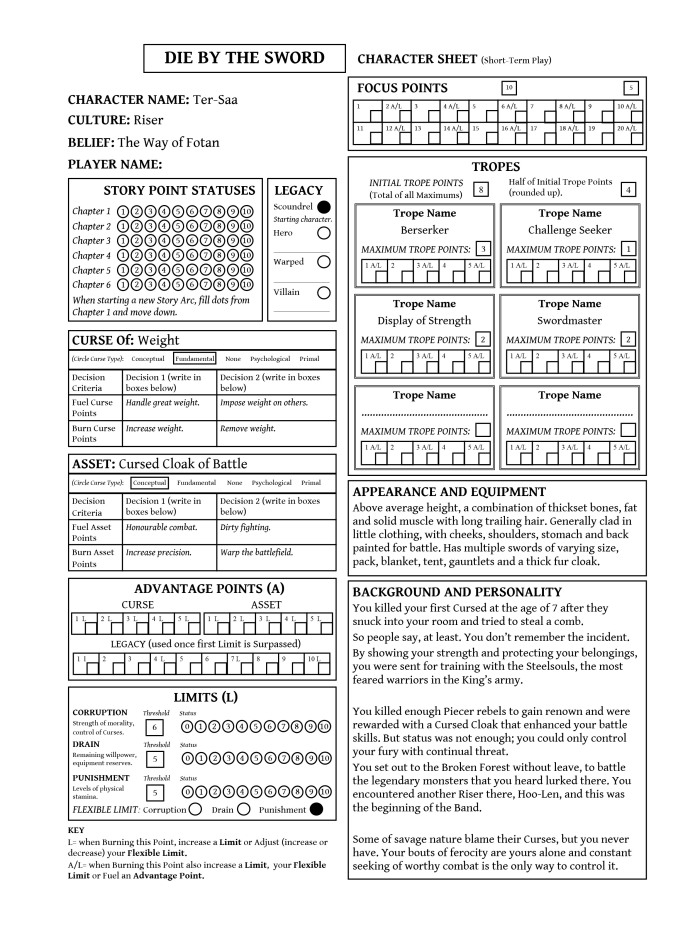
They Burn 1 Display of Strength Trope Point as this befits climbing and then 3 Focus Points just to at least match the Total.
The GM asks the player how they want to climb: they have no climbing equipment. They want to shimmy up a drainpipe. The GM decides this is not going to be a Display of Strength alone, so decides to Twist the Decision.
Your Engagement Total starts at 0, so is already below the Challenge Total, meaning the GM can Twist for any of the three options: Penalties, Scale Points and Limit increases.
They describe Ter-Saa climbing high but then sliding down the drainpipe, practically into the waiting arms of the surprised Soldier.
The GM Twists one Point to a Penalty to create a -1 as the Soldier is now closer and a greater a problem. They think some damage needs to be done here and Declare a Limit increase; the player ups Punishment by 1 as they burn their hands.
The GM decides the Soldier is more of a threat now so Twists a Scale Point, adding an Obstacle of Gaining On You, adding to the intended evasion narrative.
The player gets 3 Points Fuelled; however, their now a further -1 from besting the Challenge Total, a step closer to their Limit Threshold and on the next Engagement anyone makes, they’ve got an even higher Challenge Total to deal with.
Clearly Focus and Strength have failed Ter-Saa, so rather than Fuel them back, they Fuel 3 Curse Points, as their Curse of Weight can be Fuelled by Decisions that involve “handling great weight”, which is this case, would be trying to slide down the drainpipe enough to not fall.
Now it’s up to Ter-Saa’s player whether to make another Decision or Resolve in Failure; they may as well continue, as they only have -1 to their Engagement and have the Points they started with.
They Burn two Focus Points and two Berserker Trope Points to throw themselves on the Soldier as they approach, screaming and snarling, grappling him.
The GM does not Twist the Decision; it’s in the remit of Ter-Saa’s capabilities and the GM has not described the Soldier drawing a weapon yet, so this Decision could be advantageous.
So the Totals, match, a Stalemate… but because of the last Twist, the Soldier has Gaining On You as an Obstacle; as part of the Reaction (after a Decision, Twisted or otherwise) the GM imposes a -1 since this puts Ter-Saa right in the Soldier’s grip.
They describe the grapple going on wrong, and Ter-Saa being pushed against a wall.
It’s only one Failure Point if they Resolve, so the player might decide to accept that rather than Burn Points on another Decision. Then again, they have over half Focus Points remaining, and at least three Trope Points that might get them out of the situation, so more Decisions are certainly possible.
But is it worth Burning that many Points on one Choice… YOU DECIDE! That’s the main fun of the game.
Die By the Sword- Game-Play Example 4
Introduction
Since the last blog, I have cooked up some draft record sheets for GMs. One is attached below, showing the state of Challenges before Phase 4 of the Scene begins. It should hopefully show how easy it is to keep track of Challenges, Challenge Totals, Obstacles, Opportunity and Opposition. I have also given the Choice Totals and Target Numbers in Phase 4 in order to show how easy those are to record.
This blog ends the Bar Fight with two more Phases.
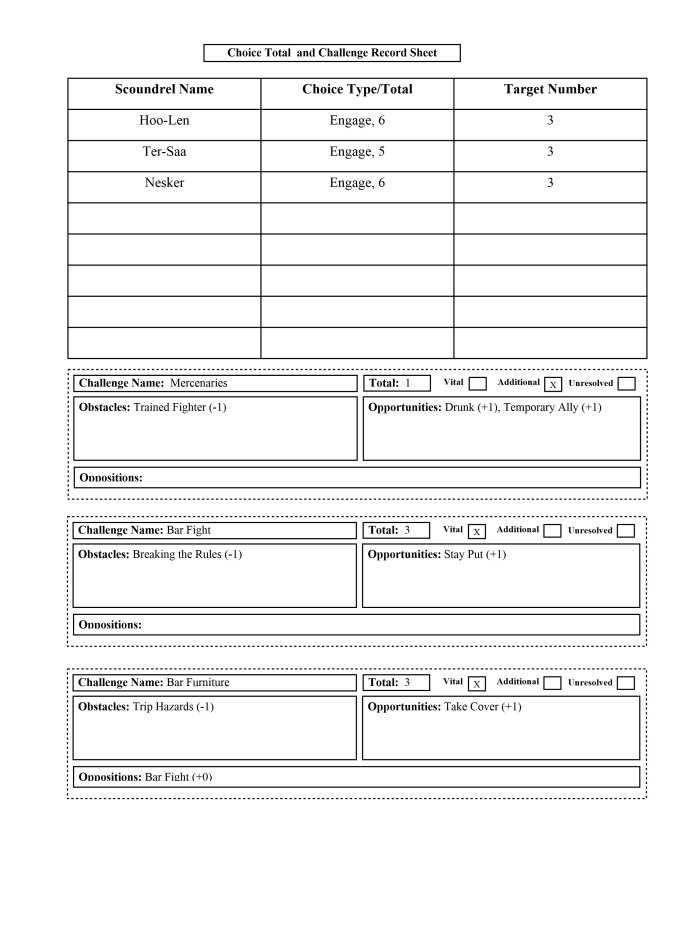
Phase 4
One of the Mercanaries is still conscious, but there is a mass of punters in between them and the Band of Mercenaries, so they are an Additional Challenge.
Bar Fight and Bar Furniture are Vital Challenges as Ter-Saa and Hoo-Len are surrounded by people surging around them and through them to get at Nesker. The Target Number for both is 3, so both Challenges can be successfully Engaged by getting a Choice Total of 4 and above.
Ter-Saa stands and fights, immediately Triggering the Stay Put Opportunity once again to begin with a Choice of 1. They spend their second and third Berserker Bonus Point of 3 (only boxes 1, 3 and 5 have Limit Adjustments, so they have one Limit Adjustment increase their Exhaustion by 1 to 4) to match the Target Number.
They spend a Focus Point and then their Asset Point for “precision” as they describe concentrating on breaking weapons with their fists. They describe cutting their hands and Adjust Injury by +1.
They Resolve a Choice Total of 5 vs 3, so 2 Success Points. They reduce Bar Furniture from 3 to 1. Due to Opposition, this is 2 lower than Bar Fight 3, so now may give the other players a +2 Bonus on their Choice against the bar fight, as their weapons are getting broken.
Hoo-Len spends a Point of Sneaky and a Point of Focus to dash under the legs of the attackers and under some tables. She Fuels 1 Asset Point for “cowardice.” (Decision: 2.) The GM describes several people turning to go around the tables after her. She spends a Point of Calculating and a Point of Sleight of Hand to trip them up by rapidly snaking out her feet. She increases her Corruption by 2 for employing her own dirty fighting. Now she is fighting back, the GM Triggers the +2 Opposition Bonus. (Decision: 6.)
Hoo-Len Resolves with 3 Success Points. She wants to use them to remove the Bar Fight Challenge (at Total 3, 3 SP will reduce it to 0). Since only their weapons have been broken or they have been tripped, the GM decides that this is inappropriate, so Triggers a Consequence, allowing them to spend the Success Point.
Instead, the GM gives Hoo-Len a temporary Trope of Getting Away with 3 Bonus Points (which they can use later in the Chapter, as well as this Scene). They also get a Victory Point for having a Consequence thrown at them to spend Success Points.
Nesker Burns 2 Points of Look What I Found! to produce some foul smelling chemicals. They Burn a Curse Point for “improve item’s capabilities”. They increase their Corruption from 2 to 4. They them Burn a Point of Eureka to mix it with something slightly explosive (and increase Corruption to the Threshold of 5). They then throw it behind the bulk of the crowd. The player Triggers the Opposition, as Nesker is still behind his shield so the crowd can hardly stop him with their improvised weapons. (Decision: 6)
Nesker’s player describes a spreading cloud of noxious gas, causing the punters to either stop to throw up or to flee and wants to spend 3 Success Points to defeat it. The GM allows it this time.
Every player earns a Victory Point for aiding in the defeat of the Challenge.
Phase 5
The drunken Mercenary is not deterred by the smell. With Hoo-Len the closest, the GM describes pursuing her. He is the only Vital Challenge.
Hoo-Len decides to crawl a chaotic route, leading the drunken merc around the bar (free +1 Bonus from the Drunk Opportunity) to make him trip and fall.
The GM decides to Burn all 3 of her Dangerous Ego Penalty Points. She counters with all 3 Getting Away Points. The Choice Total for this Decision is at 1. This is clearly “cowardice”, so she Fuels 4 Asset Points (and has 5, and can Fuel them no further, and only Burn 1 this Phase).
The GM describes the Mercenary tripping, landing and trying to grab her leg whilst she is under the table.
She spends an Asset Point for “create escape” with her Cursed Belt of Escape and with a thought, the table drops on the merc’s head and increases her Corruption to the Threshold of 4 for employing trickery.
She Resolves there with a Choice Total of 2 and defeats the Challenge with 1 Success Point, using the other to Fuel her Focus by 1, from 7 to 8. With only Bar Furniture as an Additional Challenge, the other Scoundrels are now able to make the Second Wind Choice before the Scene ends there.
Nesker has spent most of their Trope Points so Fuels them all with Second Wind, describing examining the effects of their gas. Ter-Saa describes collapsing and resting. The GM does not approve of them reducing their 2 Injury this way, but allows them to drop Exhaustion from to 3.
Each Scoundrel receives 2 Victory Points for another defeated Challenge and a successfully defeated Scene.
The Scene ends with 4-6 Victory Points earned each and 1-2 Defeat Points for 2 of the 3 Scoundrels. 10 Victory Points and 5 Defeat Points can be each traded for a Character Point in between Chapters to advance your characters statistics.
Die By the Sword Game-Play Example 3
Introduction
As before, please read the first two example blogs before reading this one.
Since posting up the other examples, I have created some alternative character sheets that get remove a lot of the wording on the main sheet and allow for putting narrative info (background etc) on the main page, so I’ll be using these for this example.
Phase 3
With one of the Mercenaries in a tussle, this Challenge remains Vital. As Nesker has created a shield to hide from the Bar Fight and flying Furniture, these Challenges are Additional; players do not have to deal with them if they do not wish to and will not have negative effects.
Ter-Saa is still pinned, even with the aid of one Mercenary. They Burn a Curse Point to “remove weight” to hurl both mercs through the air. This only Triggers the Drunk Opportunity, not Temporary Ally, putting the Choice Total at 1. They Burn a Point of Berserker for a Decision of 2 vs 4, as they roar out.

For their Limit Adjustments, they reduce Corruption from the starting value of 3 to 1.
Corruption is the only Limit you can reduce when Adjusting from Burning Points; in this case, this is throwing the mercs away from Ter-Saa and perhaps giving them an out from further fighting, so the GM approves to reduce Corruption. Ter-Saa only has a Corruption Threshold of 5, but starts with 3 (lower than normal; 5 is the standard starting value).
Increasing their Corruption rather than reducing it would have taken them beyond the Threshold, which would result in the Scoundrel embracing Corruption at the end of the story arc, which would not fit current events. Hitting Corruption 0 causes eventual retirement in a different fashion; these rules are in place to encourage the players to play anti-heroes, capable of both moral and immoral acts as situations require.
Hoo-Len goes to try and pick up her Mercenary ‘friend’, to make use of the Temporary Ally Opportunity she created (in Part 2), asking if he is okay. Adding to Ter-Saa’s Choice for a Collective Choice increases the Total to 3. However, this merc is under the other… the GM Triggers all three Penalty Points for Hoo-Len’s Weakling Trope, dropping the Choice Total to 0.
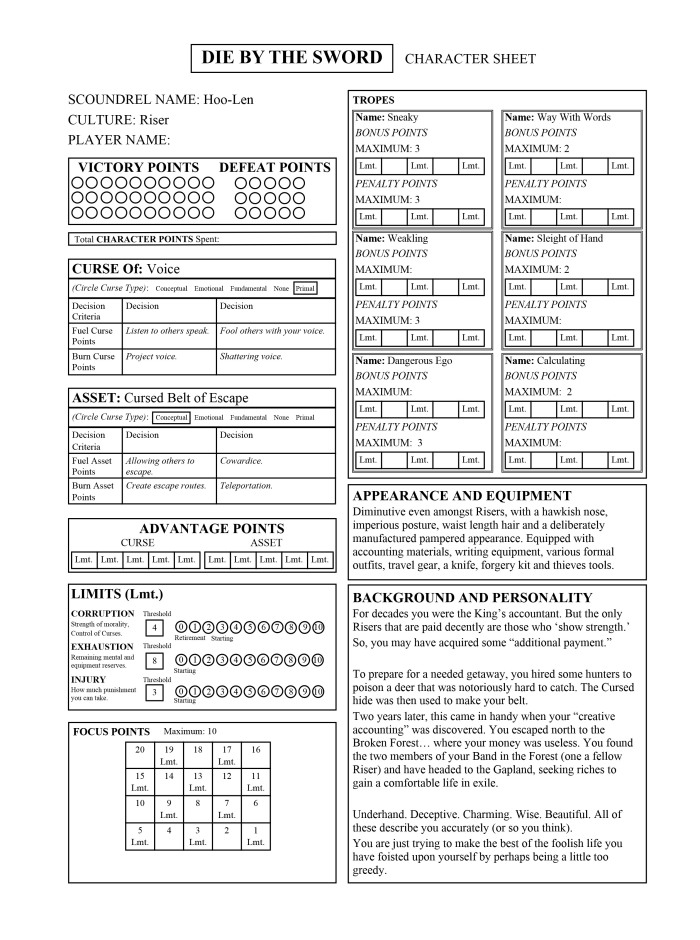
The GM describes her ally passing out as she tries and fails to tug him out from the other Mercenary. For this Decision, she gets two Status Adjustments, so decreases Corruption from 3 to 1 for at least trying to help.
The GM describes that the other Mercenary then tries to grab her. The GM Triggers the Hidden Obstacle of Mercenaries, Trained Fighter for an additional -1.
This drops the Collective Choice between the two Scoundrels to -1; only one beneficial Point has been spent from two characters, they are not yet defeated.
Hoo-Len lets out a high pitched scream in the face of the Mercenary who has her. She Burns all 4 Curse Points from her Curse of Voice for “project voice.” She describes screaming so loud that she intends him to pass out. This Decision increases the Choice Total to 3.
The Bar Fight dramatically stops (narratively, the challenge is still present).
The great cost of Advantage Points (Curse or Asset) is that they always Adjust Limits when you Burn them, which is a significant cost when spending 4 at once.
For Hoo-Len’s 4 Limit Adjustments, the player increases Exhaustion from 0 to 4.
The GM describes the Mercenary’s grip going limp. The Challenge represents two more Mercenaries; its fine to describe doing damage as you make Decisions, not just as a result of Success Points, though only Success Points will allow defeat of the Challenge.
The other two mercs draw their weapons.
Ter-Saa gathers the bottles they had prepared (scattered on the floor now but still available) and Burns both Points of Improvised Ammo, Fuelling an Asset Point for “dirty fighting” as their Limit Adjustment. They then Burn 1 their previously Fuelled Asset Point for “increase precision” and increase Corruption to 6. They cannot Burn both Asset Points as one was used Fuelled this Phase.
This increases the Collective Choice Total from to 6.
The GM describes the one of the Mercenaries drunkenly grabbing a shield but taking a blow to the temple and staggering into the other.
The Bar Fight erupts again, but remains an Additional Challenge.
Nesker decides to contribute to the Collective Choice Total, for more Success Points to bring down the Mercenaries. He takes a half-built crossbow out of his pack and hastily puts it together, and Burns a Point of Eureka and 1 Curse Point for “grant impossible capabilities to item.”
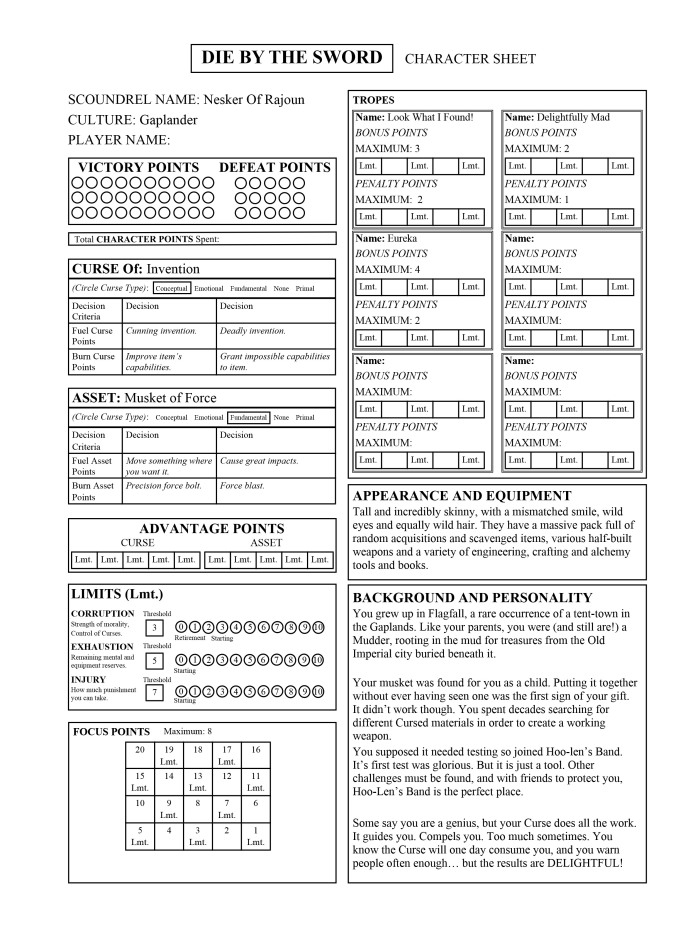
He describes firing a bolt that hits the one Mercenary’s shield with a shock-wave and tosses both against a wall. He reduces Corruption by 1 for avoiding murder as his Limit Adjustment.
However, the GM Triggers the Obstacle (-1) for Bar Fight, Breaking the Rules: nobody has been killed, but a proper weapon has been used. Now all eyes are on the Scoundrels again. Nesker has to duck again as another hail of objects is thrown.
The Choice Total is at 7. The players decide to Resolve with 3 Success Points, reducing the Challenge Total of Mercenaries from 4 to 1. Hoo-Len gets 1 Victory Point for inducing Exhaustion to achieve Success Points.
The last description by Nesker makes Bar Fight a Vital Challenge, but with all Choices made, it is also an Unresolved Challenge. The GM can Resolve against the existing Collective Choice Total, or 0 (if they feel no Choice deal with what they describe) as they wish, and they can also Trigger and Burn further Penalties they feel apply. The players cannot Burn any Points against an Unresolved Challenge, but they still must describe how they react to it (which can allow the GM to Trigger Penalties).
The players all created a Choice of 7 together to battle the Mercenaries, so it is appropriate to battle the Bar Fight as well.
As Nesker exposed himself to potential attack, the GM Burns his one Delightfully Mad Penalty Point, but as he describes ducking back behind the shield, the GM Triggers Stay Put and Take Cover Opportunities (+1 each) to increase the Total to 9.
Hoo-len is not a fighter and now horribly exposed as the bar crowd surges towards their corner, weapon in hand. The GM Burns all 3 of her Sneaky Penalty Points as it will be difficult for her to hide, reducing the Choice Total to 6. Hoo-len’s player decides Adjusting Corruption is not appropriate so increases Exhaustion by +2, as they grabbed, kicked and punched by approaching punters. Her Exhaustion Threshold is a very high 8 (she only has Injury at 3 and Corruption at 4 as a consequence), so she can risk this.
Ter-Saa describes roaring in challenge and dives in front of their boss. The GM Burns their 2 Sword Master Penalty Points and both remaining Berserker Penalty Points (as they have no sword out and their blood is up) to drop the Choice Total to 2 vs 3. They describe taking repeated punches and kicks and strikes with improvised weapons, and increase their Exhaustion from 1 to 3.
The GM Resolves with a Failure Point and gives Ter-Saa 1 additional point of Injury as they receive a barrage of hits and are likely to take more than just bruises.
They receive a Defeat Point for suffering Failure from an Unresolved Challenge, and another for Exhausting themselves against the Challenge by having Penalties Burned, as does Hoo-Len; sometimes, failure has a long term positive effect.
Nesker doesn’t suffer from the Challenge, so doesn’t receive a Defeat Point.
Die By the Sword Game-Play Example 2
Before continuing with this blog, make sure you’ve read the previous for the first part of the game-play example.
Introducing Challenges
About to hit Phase 2, and with the Scene firmly set, the GM introduces the Challenges.
As there are three players in this example, the GM can either create 1 Vital Challenge per player at Totals of 1 to 3, or two Vital Challenges, one at 1-3, the other at 4-5.
The GM decides that the armoured Mercenaries are clearly a massive and direct issue, and will be more competent than trained soldiers, so they set them to a Total of 4.
Any aggression will also cause a wider Bar Fight. There’s not likely to be much skill displayed or individual danger demonstrated by the punters, but due to the general chaos, the GM sets a Bar Fight Challenge Total at 3 (5 is the highest possible total, so 3 is a moderate threat).
There can also be an Additional Challenge of 1-3 per 2 players or 4-5 per 3 players.
They decide that Bar Furniture suits; you could trip on it, be clubbed by it, but also use it as a weapon, to hide etc. As the GM has 3 players, they set the Total to 4.
Each Challenge will have at least one Obstacle (player descriptions involving this phrase can Trigger Choice Penalty of at least -1) and Opportunity (descriptions can Trigger Bonuses instead). These begin as Hidden and are secretly decided and written down by the GM. These can be Revealed either through role-play that the GM feels makes Obstacles/Opportunities obvious, through guesses from the players or through use of Success Points.
Challenges may also have an Opposition, relating to another Challenge, where if the Totals are different, the difference may create Bonuses or Penalties as the Challenge dictates.
The GM reveals that Bar Furniture has Opposition to Bar Fight, and with 4 vs 3, anyone contending with the Bar Fight in a manner that puts them in danger of Bar Furniture will receive a -1 to their Choice. However, if Bar Furniture’s Total is reduced below Bar Fight, then Choice Bonuses may occur.
Opposition can also be created with Success and Failure Points.
Phase 2
As Ter-Saa refuses to drop the empty bottle, one of the two mercenaries that have approached the table (there are two more watching) moves in to take it.

Ter-Saa uses their other hand to grab the reaching arm, describes creating an arm lock. The GM describes the sudden movement throwing off the Mercenary’s balance, and Triggers the Challenge’s Hidden Opportunity: Drunk. They tell the player that they have Triggered an Opportunity, but not what it is (though their description should give a clue).
(Decision: Ter-Saa spends 2 Focus Points, gets a +1 Bonus from the Opp, for a Choice Total of 3 vs 4. For their Limit Adjustment, they Fuel 1 Curse Point for “impose weight on others).
The GM describes the Mercenary shoving Ter-Saa against the wall, and Triggers one of their Berserker Trope Penalty Points, as their control begins to turn into fury.
(Choice Total: 2. Limit Adjustment: Exhaustion increased to 1, as they are winded.)
There is a cry of ‘FIGHT!’ in the background. The person who yells it is punched in the face. Chaos erupts in the background.
Now, Choice Totals, via repeat Decisions, can continue to build and decline until the player decides to Resolve their Choice with either Success Points, Failure Points or Stalemate. This requires the player deciding when they have Burned enough points or when they cannot afford to Adjust any more Limits, and when to accept the fate of their Choice.
The GM can cut to other players to start making Decisions before other Choices are Resolved, as situations change in the Scene. Players can either make a separate Choice to deal with the same or different Challenges as other players (starting at 0) or a Collective Choice, adding their Decisions to that of other players.
Currently, Ter-Saa is tackling the Mercenaries Challenge; another player could Engage the Challenge by descriptively dealing with any of the Mercenaries, not necessarily the one Ter-Saa is fighting.
Hoo-Len approaches the other Mercenary that approached their table and tussling their hair, speaking in a softly softly manner, asks very nicely if they wouldn’t mind pulling their friend off of her bodyguard. She Burns her second Way with Words Bonus Point, and 2 Focus, to bump the collective Choice Total to 5. With one Limit Adjustment, she Fuels 1 more Curse Point for the Decision Criteria of “fool others with your voice.” The one merc, clearly immensely enamoured and stuttering a little, tries to pull their ally off of Ter-Saa.
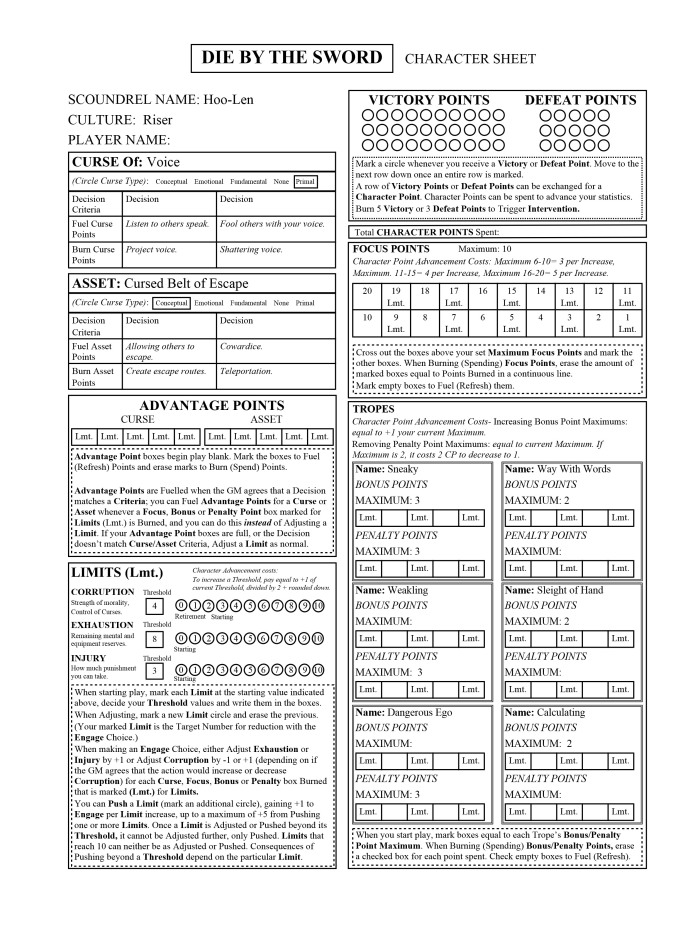
The players decide to Resolve there, getting 1 Success Point. Hoo-Len decides to use it to create a Temporary Ally Opportunity to make Mercenaries to fight. (Earning 1 Victory Point to make the story more interesting with an Opportunity, rather than reducing the Challenge Total.) They also accurately guess that the Mercenaries are also Drunk, so the GM reveals this Opportunity; with the right description, any ally can Trigger a free +2 Bonus in the next Phase.
As Ter-Saa helped create a Success Point and Exhausted themselves to do it, they earn a Victory Point. Victory Points can be saved (along with Defeat Points) and traded to enhance character stats between chapters, or spent when you have 5 of them (or 3 Defeat Points) for Intervention, dramatic help when you really need it.
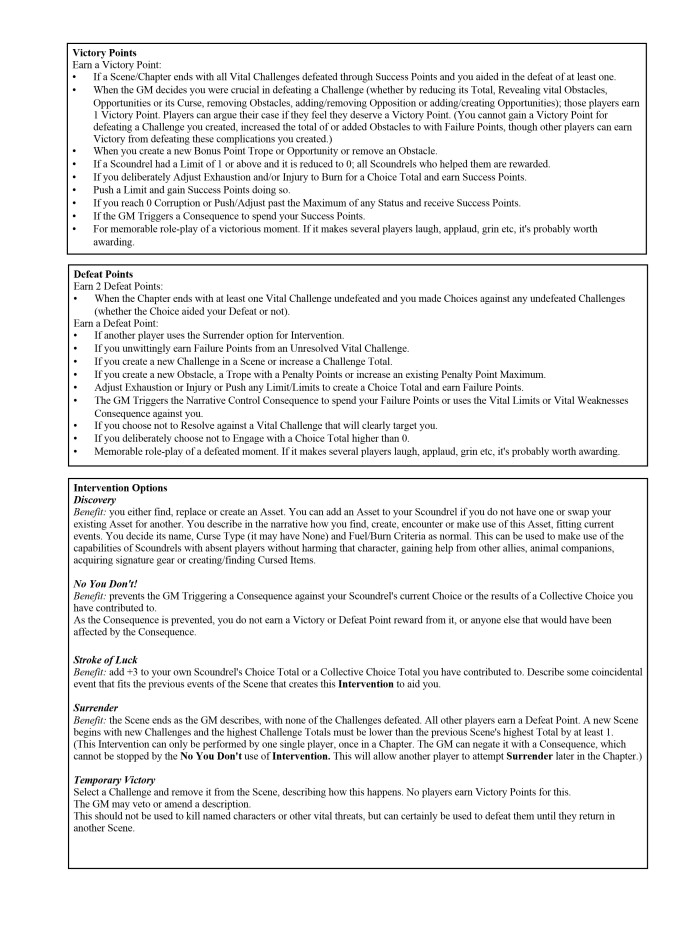
Bar Fight is a Vital Challenge. This means that if Nesker does not Engage it, there will likely be severe negative consequences at the end of the Phase.
The GM describes objects flying at the originators of the Bar Fight; this means Nesker is Engaging both Bar Fight and Bar Furniture and up against Furniture’s higher Challenge Total of 4, and receiving a -1 Penalty for Opposition.
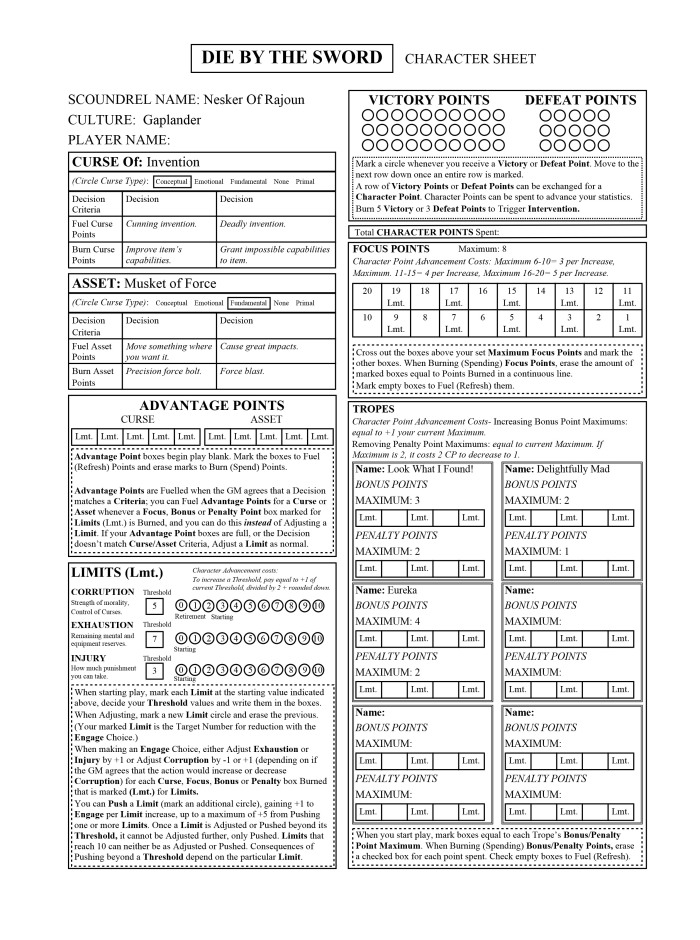
Nesker flips the table over and dives behind it. With his description, he Triggers both the Hidden Opportunities of Bar Furniture and Bar Fight (Stay Put and Take Cover); this would give a free +2, but due to Opposition, goes down to +1.
He spends a Point of Focus and a Bonus Point from Eureka, for a Decision of 3 vs 4.
With 2 Limit Adjustments, he Fuels 2 Curse Points for “cunning invention.”
The GM describes the glass of thrown bottles shattering dangerously near him.
Nesker’s player describes starting picking up the hands with his glass and madly throwing it, Burning both of his Delightfully Mad Bonus Points. For his Limit Adjustment, he decides to increase Injury to 1, due to cutting his hands. (Player can decide Limit Adjustments, but the GM has right of veto, if they are deemed to be inappropriate.) This Decision increases his Total of 3 to 5.
With 1 Success Point, Nesker reduces Bar Furniture from 4 to 3, as some of the weapons are getting broken, and the players have a shield to get behind. This has an added benefit of matching the Bar Fight and Bar Furniture Challenges Total, so Opposition is at 0.
He earns one Victory Point for choosing to increasing Injury and earning a Success Point for that Choice.
Every player has made their Choice, all Vital Challenges are Resolved, so onto the next Phase.
Die By the Sword- Game-Play Example 1
Introduction
Right, time for Part 1 of a game-play example of Die By the Sword, starring pregen characters Hoo-Len, Ter-Saa and Nesker.
These next few blogs will showcase how the basic GMing and player game-play mechanics work, as well as giving you an idea of the versatility of the character stats.
This example will feature a bar fight, and only one character might be termed a ‘combat’ character in a traditional sense.
Firstly, let’s take a look at the character sheet, via Hoo-Len, so I can get into how things are recorded on the character sheet.

Character Sheet Basics
When play begins, all Focus Points from the Maximum and below are marked. You erase them to Burn Points and tick them when Fuelling (to get Points back). For Tropes, mark the Bonus and Penalty Points up to the Maximum. Advantage Points (Curse and Asset) are blank to begin with and Fuelled during game-play. Limit Thresholds are written in the boxes; all 5s is standard, but this can be altered at character creation, as demonstrated. Starting Limits are indicated on the sheet (3 for Corruption, 0 for Exhaustion and Injury). Whenever you remove a tick from a box marked Lmt to Burn it, this will Adjust one of the Limits. Corruption can be decreased for an action that is moral in nature or increased otherwise, and the other two Limits must be increased when Adjusting. Your encouraged as anti-heroes to make both moral and immoral Choices, otherwise you will have to increase Exhaustion and Injury more often, and thus risk hitting and passing your Corruption Threshold. Instead of Adjusting a Limit, you can instead Fuel an Advantage Points, but only if the Decision you have made as part of the Choice matches one of your Curse or Asset Fuel Criteria. Players wishing to avoid increasing their Limits too far can avoid this by incorporating Advantages into their description. But they only have 5 boxes each, so Fuel them early, and you’ll be approaching Thresholds quickly. Additionally, every Advantage Point will Adjust a Limit, so these are a vital game-changer but can have dangerous ramifications if you use them too much.
Every Choice is a gamble in Die By the Sword.
Scene setting
In the first Phase of the Scene, there are no Challenges to face. Where the Scene begins is described to the players and they are encouraged to role-play, to establish character and what they want to do.
Potential Challenges may be hinted at by the GM, they may have some prepared already, but how the players role-play may indicate either a need for some different Challenges or at least a change to the descriptive nature of ones a GM may intend.
In this example, lets say the Scoundrels (player characters) have just come back from completing a mercenary mission. They are in a watering hole known as the Leaky Tap; a rough and tumble bar, commonly used by local mercenaries, sailors, criminals and other riff raff. The bar is heaving particularly heavily.
The three Scoundrels decide to secure a table in the corner. Hoo-Len is having some of the finest booze she can afford (relatively speaking) and enjoying chatting with bar staff as they approach with more drink. Ter-Saa stands silently, drinking, eyeing up the biggest, scariest, strongest looking patrons. The GM decides that one person in a group of particularly well-armed individuals notices the glance and nudges one of their fellows. Ter-Saa receives a sarcastic smile and a wave.
Nesker is mostly sitting silently too, but with occasional drinks and laughs, as he scrawls out some blueprints.
Phase 1
This is the first Phase of a Scene, so there are no Challenges to face.
Hoo-Len’s player uses her description for the Development Choice where you can either instantly Fuel 2 Points of one type (Focus, Bonus or Advantage) or Burn a Point of 1 type to Fuel 3 of another. She Burns 1 Bonus Point (out of 2) from her Way With Words Trope to Fuel 3 Advantage Points to her Curse, as one of the Fuel Criteria for the Curse is “listening to others speak.”
As she has Burned the first Bonus Point of a Trope, she erases the mark from the first Limit box (indicated as “Lmt” on the character sheet), so she reduces her Corruption by 1 to 2.
Hoo-Lin has Burned 1 point with her Choice, but has 3 other additional Points she can now use in the coming Scene at any time (whereas Way With Words, the Point Burned, was more situational).
Ter-Saa decides to make the Engage Choice. There are no Challenges to Engage, but they expect trouble, so in this case, their Target Number is 0.
The player describes grabbing some empty bottles and lining them all up in easy reach, spending 2 Focus Points as their first Decision (Decision applies when creating a Choice Total when you Engage; Decisions represent each set of points that you choose to spend, an appropriate description and then the GM’s response to that Decision, including any Penalties that occur.)
They Burn a Lmt box; the GM agrees that this matches the ‘dirty fighting’ requirement for the Asset, Cursed Cloak of Battle, and so Ter-Saa Fuels an Advantage Point for their Asset for use for later.
A Choice Total begins at 0, and is now 2; your aim as a playeris try and defeat the Target Number. There are no Challenges yet, so no Obstacles for the GM to Trigger to create Penalties. The GM can still Burn Penalties if they wish, but as a fight as not yet started, they don’t think that Sword Master or Berserker apply, so Burn no Penalties.
The GM asks Ter-Saa’s player if they wish to make any more Decisions; they decline, so the Choice is Resolved. 2 against a Target Number of 0 is 2 Success Points.
(The Choice cheat sheet breaks down the potential options for Success and Failure Points. There are no Challenges yet, so the options are limited.)
Ter-Saa creates an Improvised Weapon Trope with 2 Bonus Points; they have spent 2 Points, but gotten 3 Points in return. In addition, future Choices could be used to Fuel both the lost Focus AND the new temporary Trope, so this is a good tactical move.
They gain a Victory Point for creating a Trope and making the ensuing Scene a little more interesting. (More on Victory Points later.)
Nesker is creating blueprints for an invention rather than haphazardly building one, so the player uses Development to Burn the Penalty Points from their Eureka Trope from 2 down to 1; this will give the GM less room to screw the player with inventions they create throughout the coming Scene.
Ending Phase 1
The armoured mercenaries approach and “what are you looking at?” dialogue inevitably occurs aimed at Ter-Saa. The warrior refuses to answer, one of the opposing mercs, knocks a drink over, Ter-Saa lifts a bottle.. you know the drill.
Next Time…
I explain how Challenges are introduced and how they work and get into the second Phase of the Scene, where the bar fight proper begins.
Die By the Sword Part 2- Interacting With The Game World
Time for part 2 of going into greater detail about Die By the Sword!
If you haven’t read the first blog, I would recommend looking at that first.
The Setting Basics
You live in the Cursed Lands, what remains of the Central Continent. History is sketchy due to the fact that most of mankind on the continent died out when the continent was ripped to pieces, and most of the cities of the Blessed Empire were destroyed or at least ruined.
But what you do know is there used to a veil of energy out to sea, surrounding the Continent, known as the Curtain. The Blessed Empire believed that beyond it lay the path to their God. When they could not pass the Curtain, they sought a way through.
Again, history is sketchy, but eventually, their path into the Curtain released the Primordials. Ancient beings embodying every single building block of the world: a Primordial representing every idea or concept ever conceived, every possible emotional, the fundamental physical and metaphysical parts of the world and every aspect that makes a living creature, as well as representing each distinct creature.
As history tells it (or what little you have) these beings did not care for Humanity. They ignored you. And they sought out like Primordials, and sort to drain and destroy opposing Primordials, the settlements of the Empire were ruined.
Eventually, something was done to remove them from the world. Unfortunately, you don’t know how.
Unfortunately, you cannot destroy energy, only disperse it.
The Curtain is gone now. And each Primordial dispersed into fragments. But their seeming destruction forever changed the lands.
Volcanoes forever rage to the north, destroying whatever cities once lay there. The bulk of remaining cities south of there were ravaged by earthquakes, most dropped into fissures or plunged into the earth. The rain-forest at the centre of the continent was partially flooded, miles high trees pulled in on top of each other, into what now looks like a giant, dead bird nest from afar. Most of the south of the continent was pulled into the sea, and now only the tiniest islands and tallest mountain peaks remain.
And every fragment of Primordial infected either an area of land, person or animal. These fragments became known as Curses.
Welcome to the Cursed Lands.
Most Curses will never manifest. Curses feed on the very essence of what they are, drawing strength from what embodies them. Some have requirements that will never be met. Others are, perhaps constantly, but it would necessarily be known.
A field may have a Curse of Sadness. Until the day when a young woman spurned by her her lover came to sit in the lonely tree in that field and cry, the Curse was never Fuelled. And the farmer who came to that field the following day and suddenly felt an immense depression fall upon him would never necessarily know a Curse was at play.
Much as the farmer himself will have a Curse. He may have a Curse of Happiness. Every time one of his Decisions makes himself or another happy, he feeds the Curse. He may live out his days, subconsciously Burning his Curse, making others happy. To his neighbours, he is just a happy guy, and his Curse is unknown. Until the day raiders came to burn down his farm. They’d already murdered and done worse to his wife. And yet he tried to plead with them. I mean, if you were terrified, you would. But the farmer would never expect it to work. When all the raiders smile, not only let the farmer go, but give him supplies for the road, perhaps then, he realises he has his Curse.
But a Curse of Happiness must be fed and this doesn’t mean the farmer himself is happy. Now, happiness will be more difficult to achieve. But he knows his Curse and how to use it. He goes to a nearby village, giving them freely his supplies. They’re very happy with this, and his Curse is Fuelled at least partially. He trades the supplies for weapons. He returns to his farm. The raiders see him… and drop their weapons, welcoming him with open arms, ready to give him a hug. The farmer repeatedly stabs the raider in the belly.
This is the day the farmer becomes a Scoundrel.
in Die By the Sword, all player characters are Scoundrels. A mix of good and bad. They aren’t necessarily all consciously aware of their Curses. But they are stronger, and more dominant than those around them, and they are making changes in the world, for good or ill.
You will tell the story of one such Band of Scoundrels.
Framing the Game
Like all of my games, there is a mechanic in place for framing that ensures all players will definitely have the opportunity to do things an equal amount. I like to ensure that the quieter and more thoughtful players, as well as those who just take longer to make decisions, get their chance to shine amongst quicker thinking, more confident players.
In this case, the concept is that you are playing characters in a fantasy novel, series of novels, novella or short story. Therefore, games are presented as Chapters, which split into Scenes. In each Scene, once a player wishes to do something where success or failure are introduced, the first Challenges are introduced. When you wish to do something, you pick from one of three Choice Types: Development, Engage and Second Wind. Once everyone has made a Choice, move onto the next Phase, and continue the Scene either until all Vital Challenges are defeated or the remaining Challenges are no longer Vital (no longer a constant narrative concern for the characters).
Scenes break down into Phases. Once you’ve picked a Choice Type, the GM records this as your Choice for the Phase. You can carry on role-playing, but as soon as you try to do something else Choice-worthy, it’s time for the GM to ensure every player has had their spotlight, before you go to the next Phase, and you get to make another Choice
Here is the optional sheet accompanying the character sheet that breaks the three Choices down in full if we wish to take a look (otherwise I summarise them next).

Interacting With the Game World
Development will either let you regain Points you have lost so you can use them to Engage later or will allow you to gain Advantage Points (which you start with zero of, so can be the extra mileage you need when Engaging later).
Engage will either let you: attempt to reduce or gain benefits against Challenges in the Scene (with the potential risk of Failure), let you make a Choice Total against half of the Challenge’s Target Number (you cannot affect its Total, but you can make preparations, such as making Flaming Arrows as a new Trope or goading an enemy to Engage them as an Opportunity), Engage against 0 (to either make observations about the general scene or make/preparations interactions that do not relate to facing a particular Challenge) or Engage against Trope Penalties or Limits, with their Maximums or current numbers as Target Numbers, in an attempt to reduce them.
Second Wind can only be made when there are no Vital Challenges threatening you (which is going to be rare for most characters at most times). Second Wind allows you to get a large amount of Points of one type back or allows significant Limit Adjustment.
Players working with high Points may be able to give players with low Points and high Limits the chance to recover by Engaging Vital Challenges. Any Vital Challenge that is Unresolved by the end of the Phase will use its Total against at least one Scoundrel. If the GM decides their Choice Total is not a valid defence, they get 0. If they did not Engage, the Choice is at 0. If their Choice Total is a valid descriptive defence against the Challenge, either way the GM can Burn Penalty Points the player has to reduce their Choice Total, and the player cannot Burn any Points in response. However, they still need to Adjust Limits; just by reducing a Choice Total, the GM can inflict some literal damage on a player, so its important to work together and Engage those Vital Challenges.
Next Time…
I am going to get into an in-depth game-play example over several blogs, in order to show you the game in action.
The Next Game- Die By the Sword
Introduction
So once again, I am diving into the world of “diceless role-playing games that are actually closer to more narrative-influenced mechanics dice-based games than they are most diceless games” with Die By the Sword.
I have been posting bits and pieces about this on my Facebook and Twitter, but have still been nailing the core mechanics. They are now pretty much nailed, so I am making this blog to introduce (or re-introduce) to the basics of Die By the Sword.
The Basic Mechanical Concepts
For those reading this and entirely unfamiliar with this concept that I have only been hard testing for about six weeks, the basic principle is that you spend from Points to create Totals to defeat Target Numbers. The more Points you spend, the more you have to combat a Total, but the less you have for later, the more you incur negative effects for spending those Points (Exhaustion and Injury), and the more ground the GM has to throw Penalties at you for your continued description.
The game system (I am currently terming it the Burn System) works on the concept of making Choices to either Burn (spend) Points to complete tasks or Fuel (refresh) them for use later, to gain extra Points (Advantage Points) for more impressive feats or to Adjust (usually decrease) your Limits. The more you Burn, the more you will need to Adjust Limits to compensate. Your Corruption can go up and down for moral and immoral tasks. Injury and Exhaustion will increase only when Burning, or if you get Failure Points (more on those later).
Here is the single draft character sheet so you can see what I am talking about.
 Delving a Little Deeper
Delving a Little Deeper
Limits have Thresholds. If you Adjust the Limit past the Threshold, you can never Adjust it again when Burning Points. This means that Burning becomes more dangerous, as you only have two Limits to Adjust rather than 3, though you always have the possibility of Fuelling Advantage Points instead.
You can Push a Limit before or after it passes a Threshold; every Push increases the Limit, but gives a +1 on the Choice Total. Good for when your Points are running low and you are desperate, or if your Limit is past a Threshold and otherwise useless. Push or Adjust Corruption past your Threshold and you are fundamentally changed and retired at the end of the story arc (same with different results if it hits zero), Push Injury past the Threshold and you are retired at the end of the Chapter. Push Corruption or Injury to 10… that’s an instantly retired character. Say you have an Injury Threshold of 5 and zero Points. You could fight on, Pushing Injury to 10, get +5 on a Choice, and die like a badass. Push to 9, and you live on for now, but if you’re Points are lacking, you can role-play a way but likely do little else. Pushing will not Fuel Advantage Points, so this is largely what you do when you have little else left.
Your Curse is a supernatural capability you may have (and most characters will have). Your Asset can be anything from a Cursed Item, a notable item, a notable trait or companion of some form. These are your two Advantage Point options.
Each have two Decision options for Fuelling; when you make the Engage Choice, this breaks down into at least one, perhaps multiple Decisions, descriptive actions that represent the Points you Burn to add to the Choice. You write the Decisions when you make the character. It should broad enough that it will come often in play, but not so broad that it will come up all the time.
For example, if you have the Curse of War “fighting” and “killing” would not be legal Decisions for Fuelling. Too broad. However “fighting fair” and “killing with abandon” are more specific, but will also come up often, if you wish them too. However, the Curse requires combat to Fuel, which is a limitation in itself.
When Burning Points, you Adjust Limits when you erase the tick (ticks representing Fuel) from a box marked ‘Lmt.’ When you do so, you must either Adjust a Limit or Fuel an Advantage Point (Curse or Asset). However, you can only Fuel Advantages if matching their Fuel Criteria, and once the 5 boxes for each are Fuelled, they can be Fuelled any more until you Burn them.
Advantages also have Burn Criteria. You can essentially use these whenever, you just state a broad effect of what happens when you make use of your Curse or Asset. Curses are supernatural in nature, but the Burn effects don’t have to be obviously supernatural.
As Burn Decisions for War, “stabbing” and “mass death” would again be not specific enough. However “increased combat skill” and “inspire bloodlust” are more specific, whilst still being broad enough to provide the player with plenty of ideas.
You cannot Burn Advantage Points until the Phase after you acquire them.
Example: a player is up against a bog-standard bunch of conscripts, represented by the Soldier Challenge (Target 2). There are five of them, advancing with swords drawn. None have shields. The player spends a Point of Focus to drop their shield and approach their enemies, swords raised, giving them one last time to run. As the first Point spent, this Adjusts a Limit. But because this matches their Curse of War’s “fighting fair” Fuel Criteria, they Fuel a Curse Point instead. The player wants to see what the Soldiers do before spending more Points (they are currently one below the Target Number) so they counts as a Decision. The Soldiers charge in, so the player spends 2 more Focus (1 Limit Adjustment) and gains a second Curse Point, describing constantly moving between the enemies, deflecting sword blows, trying to get around them. The player is fighting in their specialised area, and less likely to take negative effects here. They will likely have at least one Trope based around combat too; let’s say they have “Professional Killer.” They Burn a Bonus Point from it, describing getting behind a Soldier and stabbing through a weak point in their armour. They now have a Choice of 3 against 2. 1 Success Point. They choose to drop Soldiers from a Total of 2 to 1.
On the next Phase, the four remaining soldiers advance. The player describes weaving their sword left and right and doubling their speed, aiming to cut down as many as possible, Burning their Curse Points to get to 2 already. That’s 1 Success Point off the bat. Unless the GM throws in some Penalties, this could be an instant win. But at a cost. The player increases Injury by 2, making a big description of cutting down each Soldier, but taking many slashes in the process.
Now, when spend Advantage Points, every box Adjusts a Limit. You cannot Fuel Advantages by Burning them. You can Adjust Corruption up or down. But there is nothing particularly corrupt or not corrupt about some descriptions; killing is often just a necessity of the situation, it’s how you kill that may be corrupt. And if your Corruption is at your Threshold and you describe a corrupt Decision… you still can’t increase Corruption without retirement. So Exhaustion or Injury are inevitable in certain situations unless you make a point of an array of moral and immoral decisions. In the game you play Scoundrels, anti-heroes, so being ultimately grey is a very much deliberate design decision.
An average character will have each Threshold at 5. You can have higher, at the cost of lowering the other two Thresholds. With a higher Injury Threshold and a lower Corruption Threshold , you are more likely to Adjust Injury than Corruption.
So hopefully you see where the risk starts to come in. And I will cover that further in later blog.
Next Time…
On the next blog I am going to discuss more about the framing mechanics, the three different Choices you can make and get a little into the setting.
Is It a Plane!? Promo Events
GREETINGS READERS!
I have a few more things on to help promote the Is It a Plane!? Kickstarter over the next few weeks.
Dan Davenport will be interviewing me about the Is It a Plane!? Kickstarter project
US time: 05/16/2018 7:30 p.m. CDT
UK time: 17/05/2018 00.30 (half past midnight).
Head to the link here to sit in on the chat (and ask questions) if you like.
The chat will be logged and later posted on:
Bamf Podcast Interview, 17th May
On Thursday evening (9-10 UK time) I am being interviewed by Mike Lafferty on the Bamf podcast.
Kickstarter Launch Party, 19th May, Geek Retreat Birmingham, UK, 10am-7pm.
Two of my GM playtesters will be running a cosmic crossover of epic proportions, and I will be on hand to run game demos for people that wander upstairs, as we attempt to take the upper floor of the cafe over.
24 Hour RPG Event, 19th/20th May, Asgard Games, Walsall, UK, 10pm-2am.
I’ll be running a promo game of the Midnight Watch scenario.
UK Games Expo, Birmingham UK, 1st-3rd June
There will be a Psychic Cactus Games stall. When I am not running game slots, I’ll be on the stall (about 50% of the time). There will be the opportunity to try out game-play demos of It Is a Plane!? (which can be easily demonstrated in about 10 minutes). If I am not on the stall, one of my GM playtesters will be.
That’s all for now!
Commander Chris awaaAAAAY!
WHOOSH!
Is it a Plane in action!?- The Menagerie
Introduction
At this year’s Student Wargaming and Roleplaying Nationals, I ran two games of Is It a Plane!? One of the players loved the game so much, he asked for the Google Doc, and ran a playtest game entirely independent of me at a charity gameathon.
Following are the photographs of every Visual Phase of the game, with an explanation of each to explain what happened.
This should give you an idea of what the Editor’s role is like in interpreting Panels. It also showcases the actions of six different players. It is my hope that photos like these will discourage the worries people have about not being able to draw to play this game, as a range of capabilities are showcased here.
The Heroes


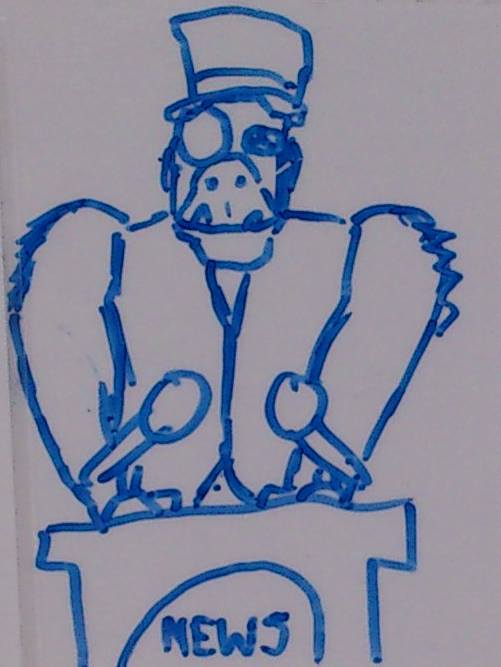



The Story
The supervillains Lightning Rod and Thunder Ella are on the loose, and have staged a prison breakout to unleash a crime wave on the city!

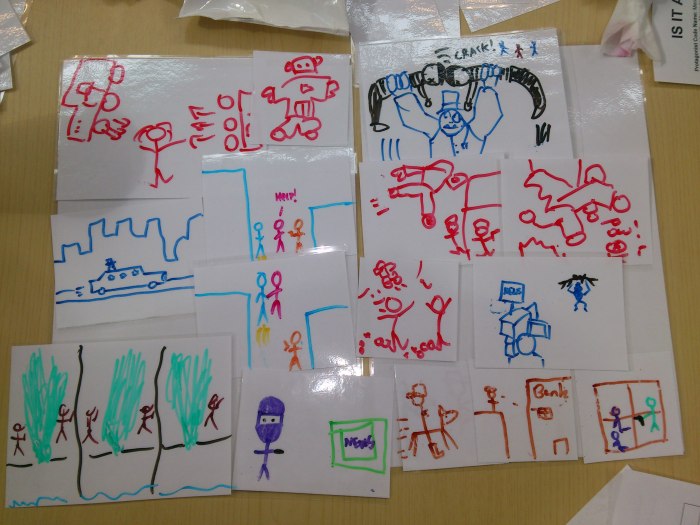

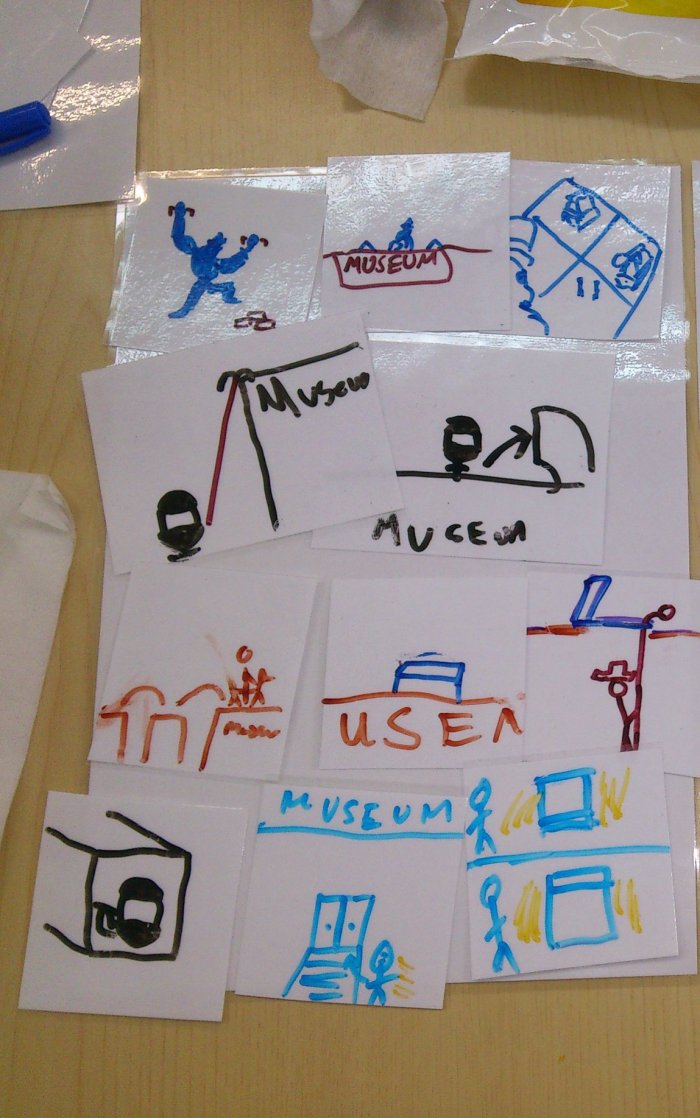


Then, suddenly… TechKnight makes their drones set off the sprinklers! That’ll help stop Lightning Rod using his electric powers with precision… but might lead to more collateral damage! Then Six Gun strikes! She snatches Thunder Ella’s umbrella to deprive her of most of her storm powers! TechKnight, that rule-breaking rebel, enters the museum through a door clearly marked EXIT. Greystoke crashes down through the skylight to take the villains by surprise! Mercy Kill sneaks out of her air vent to rescue the curator while the villains are distracted! Frogwizard re-forms himself on the inside of the museum and casts Ray Of Frogs at the villains, narrowly missing Lightning Rod!
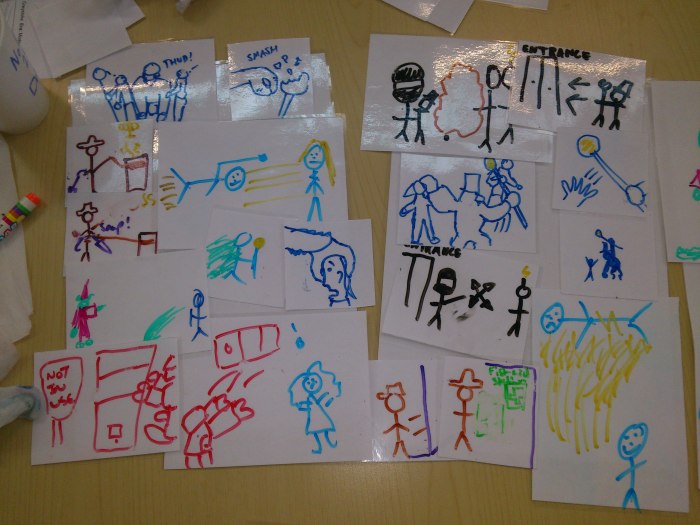
Meanwhile, Mercy Kill uses a ninja smoke bomb to cover her getting the curator out of the museum to safety, then flings a shuriken at Lightning Rod! Six Gun grabs a first aid kit to quickly patch herself up. Greystoke snatches Lightning Rod’s rod form his hand and hold it out of the villain’s reach! Gust grabs the disarmed villain with a wind blast, flinging him into the air!

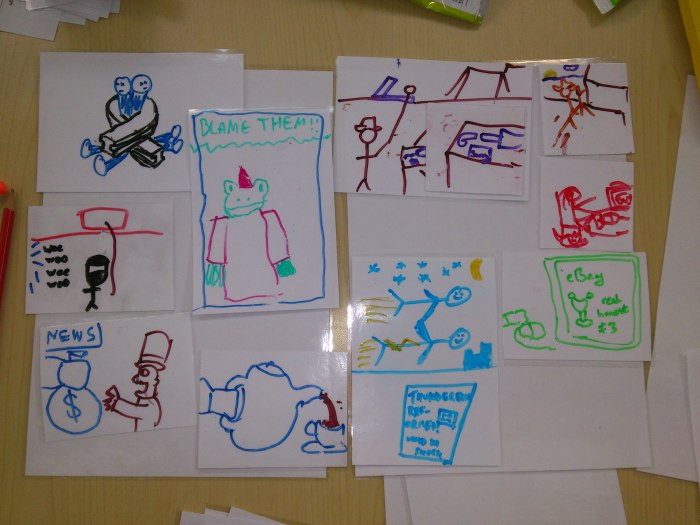
Gorilla Greystoke has restrained Lightning Rod and Thunder Ella by bending a metal bar around them. Mercy Kill, hearing the sirens of the police, decides to make a sneaky exit back out through the air vents before they arrive. The media are not impressed with the destruction of the priceless ancient artifacts – and number one on their hit list is Frogwizard! Greystoke helps smooth things over with a large donation to the museum directors, then relaxes with a well-earned pot of tea. Six Gun swings herself back up onto the roof of the museum where she’d parked her horse, and rides off into the sunset. TechKnight goes on eBay – wait, is that a priceless artifact they’re selling? I guess they’ve got to pay the bills somehow!
Finally, some time later, Thunder Ella is paroled – and she seems to be spending a lot of time with Gust! How sweet! What a heartwarming end to the issue… OR IS IT?
THE STINGER: A shadowy figure looks on at the carnage, and says “By the Death of Yesterday…” DUN DUN DUN!
